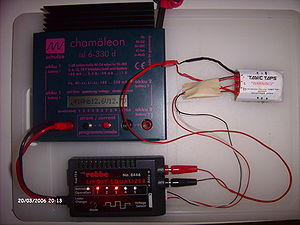
Battery balancing
Encyclopedia

Battery (electricity)
An electrical battery is one or more electrochemical cells that convert stored chemical energy into electrical energy. Since the invention of the first battery in 1800 by Alessandro Volta and especially since the technically improved Daniell cell in 1836, batteries have become a common power...
's capacity to make all of its energy available for use and increase the battery's lifetime. A battery balancer or battery regulator is a device in a battery pack
Battery pack
A battery pack is a set of any number of identical batteries or individual battery cells. They may be configured in a series, parallel or a mixture of both to deliver the desired voltage, capacity, or power density...
that performs battery balancing. Balancers are often found in Lithium ion battery
Lithium ion battery
A lithium-ion battery is a family of rechargeable battery types in which lithium ions move from the negative electrode to the positive electrode during discharge, and back when charging. Chemistry, performance, cost, and safety characteristics vary across LIB types...
packs for cell phones and laptop computers. They can also be found in battery electric vehicle
Battery electric vehicle
A battery electric vehicle, or BEV, is a type of electric vehicle that uses chemical energy stored in rechargeable battery packs. BEVs use electric motors and motor controllers instead of, or in addition to, internal combustion engines for propulsion.A battery-only electric vehicle or...
battery packs.
Typically, the individual cells in a battery have somewhat different capacities and may be at different levels of State Of Charge (SOC)
State of charge
State of charge is the equivalent of a fuel gauge for the battery pack in a battery electric vehicle , hybrid vehicle , or plug-in hybrid electric vehicle...
. Without redistribution, discharging must stop when the cell with the lowest capacity is empty (even though other cells are still not empty); this limits the energy that can be taken from and returned to the battery.
In a balanced battery, the cell with the smallest capacity can be filled without overcharging any other cell, and it can be emptied without over-discharging any other cell. Battery balancing is done by transferring energy from or to individual cells, until the SOC of the cell with the lowest capacity is equal to the battery's SOC.
Battery redistribution is sometimes distinguished from battery balancing by saying the latter stops at matching the cell's state of charge (SOC)
State of charge
State of charge is the equivalent of a fuel gauge for the battery pack in a battery electric vehicle , hybrid vehicle , or plug-in hybrid electric vehicle...
only at one point (usually 100% SOC), so that the battery's capacity is only limited by the capacity of its weakest cell.
A full Battery Management System
Battery Management System
A battery management system is any electronic system that manages a rechargeable battery , such as by monitoring its state, calculating secondary data, reporting that data, protecting the battery, controlling its environment, and / or balancing it.-Monitor:A BMS may monitor the state of the...
(BMS) might include active balancing as well as temperature monitoring, charging, and other features to maximize the life of a battery pack.
Technology
Balancing can be active or passive. The term battery regulator typically refers only to devices that perform passive balancing.In passive balancing, energy is drawn from the most charged cell and is wasted it as heat, usually through resistors.
In active balancing, energy is drawn from the most charged cell and transferred to the least charged cells, usually through DC-DC converters.
Active balancing is usually more efficient than passive balancing, but not always.
Battery balancing can be performed by DC-DC converters, in one of 3 topologies:
- Cell-to-battery
- Battery-to-cell
- Bidirectional
Typically, the power handled by each DC-DC converter is a few orders of magnitude lower than the power handled by the battery.
External links
- Li-Ion Balancing Battery Management Systems, parametric selector
- http://www.rotordesign.com/s10/Clamper.pdf
- Plasmatronics
- Some Battery Management System
- Battery Management Systems

